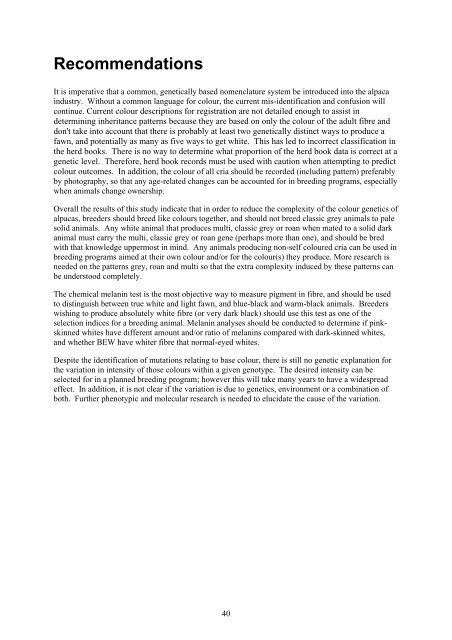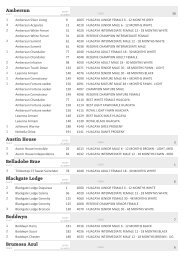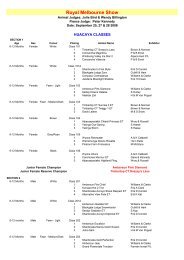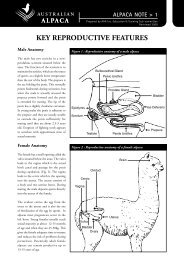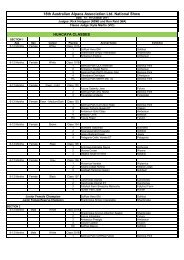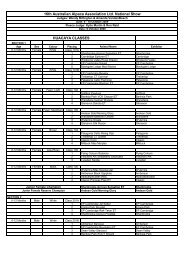Inheritance of White Colour in Alpacas - Australian Alpaca Association
Inheritance of White Colour in Alpacas - Australian Alpaca Association
Inheritance of White Colour in Alpacas - Australian Alpaca Association
Create successful ePaper yourself
Turn your PDF publications into a flip-book with our unique Google optimized e-Paper software.
Recommendations<br />
It is imperative that a common, genetically based nomenclature system be <strong>in</strong>troduced <strong>in</strong>to the alpaca<br />
<strong>in</strong>dustry. Without a common language for colour, the current mis-identification and confusion will<br />
cont<strong>in</strong>ue. Current colour descriptions for registration are not detailed enough to assist <strong>in</strong><br />
determ<strong>in</strong><strong>in</strong>g <strong>in</strong>heritance patterns because they are based on only the colour <strong>of</strong> the adult fibre and<br />
don't take <strong>in</strong>to account that there is probably at least two genetically dist<strong>in</strong>ct ways to produce a<br />
fawn, and potentially as many as five ways to get white. This has led to <strong>in</strong>correct classification <strong>in</strong><br />
the herd books. There is no way to determ<strong>in</strong>e what proportion <strong>of</strong> the herd book data is correct at a<br />
genetic level. Therefore, herd book records must be used with caution when attempt<strong>in</strong>g to predict<br />
colour outcomes. In addition, the colour <strong>of</strong> all cria should be recorded (<strong>in</strong>clud<strong>in</strong>g pattern) preferably<br />
by photography, so that any age-related changes can be accounted for <strong>in</strong> breed<strong>in</strong>g programs, especially<br />
when animals change ownership.<br />
Overall the results <strong>of</strong> this study <strong>in</strong>dicate that <strong>in</strong> order to reduce the complexity <strong>of</strong> the colour genetics <strong>of</strong><br />
alpacas, breeders should breed like colours together, and should not breed classic grey animals to pale<br />
solid animals. Any white animal that produces multi, classic grey or roan when mated to a solid dark<br />
animal must carry the multi, classic grey or roan gene (perhaps more than one), and should be bred<br />
with that knowledge uppermost <strong>in</strong> m<strong>in</strong>d. Any animals produc<strong>in</strong>g non-self coloured cria can be used <strong>in</strong><br />
breed<strong>in</strong>g programs aimed at their own colour and/or for the colour(s) they produce. More research is<br />
needed on the patterns grey, roan and multi so that the extra complexity <strong>in</strong>duced by these patterns can<br />
be understood completely.<br />
The chemical melan<strong>in</strong> test is the most objective way to measure pigment <strong>in</strong> fibre, and should be used<br />
to dist<strong>in</strong>guish between true white and light fawn, and blue-black and warm-black animals. Breeders<br />
wish<strong>in</strong>g to produce absolutely white fibre (or very dark black) should use this test as one <strong>of</strong> the<br />
selection <strong>in</strong>dices for a breed<strong>in</strong>g animal. Melan<strong>in</strong> analyses should be conducted to determ<strong>in</strong>e if p<strong>in</strong>ksk<strong>in</strong>ned<br />
whites have different amount and/or ratio <strong>of</strong> melan<strong>in</strong>s compared with dark-sk<strong>in</strong>ned whites,<br />
and whether BEW have whiter fibre that normal-eyed whites.<br />
Despite the identification <strong>of</strong> mutations relat<strong>in</strong>g to base colour, there is still no genetic explanation for<br />
the variation <strong>in</strong> <strong>in</strong>tensity <strong>of</strong> those colours with<strong>in</strong> a given genotype. The desired <strong>in</strong>tensity can be<br />
selected for <strong>in</strong> a planned breed<strong>in</strong>g program; however this will take many years to have a widespread<br />
effect. In addition, it is not clear if the variation is due to genetics, environment or a comb<strong>in</strong>ation <strong>of</strong><br />
both. Further phenotypic and molecular research is needed to elucidate the cause <strong>of</strong> the variation.<br />
40


